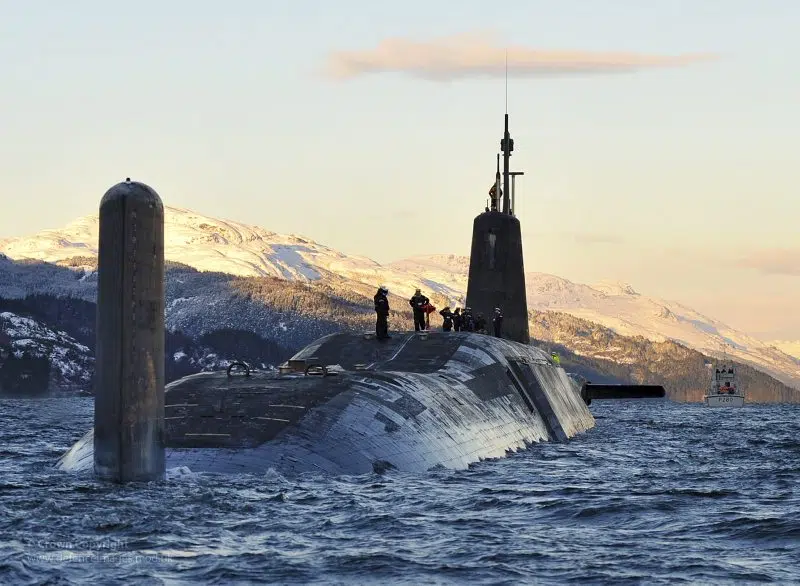
The Royal Navy’s latest Astute Class submarine built by BAE Systems, due to be launched later this year, has been officially named Agamemnon, after the ancient Greek king.
Agamemnon was officially named at BAE Systems’ Submarines site in Barrow-in-Furness, Cumbria and is the sixth of seven Astute Submarines being built by the company. It will be commissioned into the Royal Navy after being launched later this year.
The ceremony was attended by the Minister for Defence Procurement and included an address by the vessel’s Lady Sponsor, Lady SJ Sedwill, the wife of former UK National Security Adviser Lord Mark Sedwill.
Agamemnon was then blessed and christened with a bottle of beer from the local Ulverston Brewing Company smashed against her hull.
“This is a key milestone for Agamemnon and the UK nuclear submarine programme, and contributes to the Government’s Defence Nuclear Enterprise Command Paper, which underpinned the importance of our business and Barrow in delivering this national endeavour,” Steve Timms, Managing Director, BAE Systems’ Submarines business told the “UK Defence Journal.”
He added, “The Astute Class submarines are a vital component of our nation’s defence capabilities and we are fully focused on completing the remainder of Agamemnon’s programme so she can join her sister submarines in service with the Royal Navy.”
Five Astute Class submarines are in service already, with work also well underway in Barrow on the seventh and final vessel.
“HMS Agamemnon will play a vital role in defence of the nation, providing our Armed Forces with a competitive edge for decades to come. The Astute Class programme continues to support tens of thousands of jobs, with these submarines being a leading example of our commitment to investing in British sovereign capabilities,” said Minister for Defence Procurement James Cartlidge.
The Astute Class submarines are 97-meters-long and weighs 7,400 tons with advanced nuclear technology which means the vessels never need to be refueled. They can produce their own oxygen and fresh water from the ocean and are able to circumnavigate the globe without surfacing.
The Astute Class is fitted with both Tomahawk Land Attack Cruise Missiles (TLAM) and Spearfish heavyweight torpedoes.
According to BAE Systems, “As the home of UK submarine design and build, the UK Government, through the Ministry of Defence are investing with BAE Systems to expand the Barrow shipyard in preparation for an exciting future. In addition to the Astute Class, construction is underway on the first three boats in the Dreadnought Class, which is the next generation of nuclear deterrent submarines that will replace the current Vanguard Class.”
The company added: “BAE Systems is also developing the SSN-AUKUS programme, as part of the trilateral security pact between Australia, the UK and America. Under the AUKUS agreement, Australia and the UK will operate a common submarine of the future, incorporating technology from all three nations, based on the UK’s next generation design, which BAE Systems is leading.”
Royal Navy ships named after ancient Greek figures and myths
Many Royal Navy ships throughout history have been named after figures and creatures from ancient Greek mythology.
Six ships of the Royal Navy have been named HMS Charybdis after the sea monster of ancient Greek mythology. The first of these ships was commissioned in 1809—an 18-gun brig-sloop in use until 1819. She apparently became the Whaler Greenwich which made three complete voyages and then wrecked in the Seychelles in 1833 while on her fourth.
HMS Naiad, named after the female spirits or nymphs of Greek mythology that presided over fountains, wells, springs, streams, brooks, and other bodies of fresh water, was a Leander-Class frigate of the Royal Navy. HMS Naiad was built by Yarrow Shipbuilders of Scotstoun and was launched on November 4, 1963. It was commissioned on March 15, 1965.
The Royal Navy also commissioned HMS Hercules, a 20,000-ton dreadnought battleship of the Colossus class, which was built by Palmers at the company’s dockyard at Hebburn in northeastern England and launched in 1910. Among several other ships of the same name.
This is in addition to the HMS Calliope, named after the muse of epic poetry in ancient Greek mythology.
See all the latest news from Greece and the world at Greekreporter.com. Contact our newsroom to report an update or send your story, photos and videos. Follow GR on Google News and subscribe here to our daily email!



